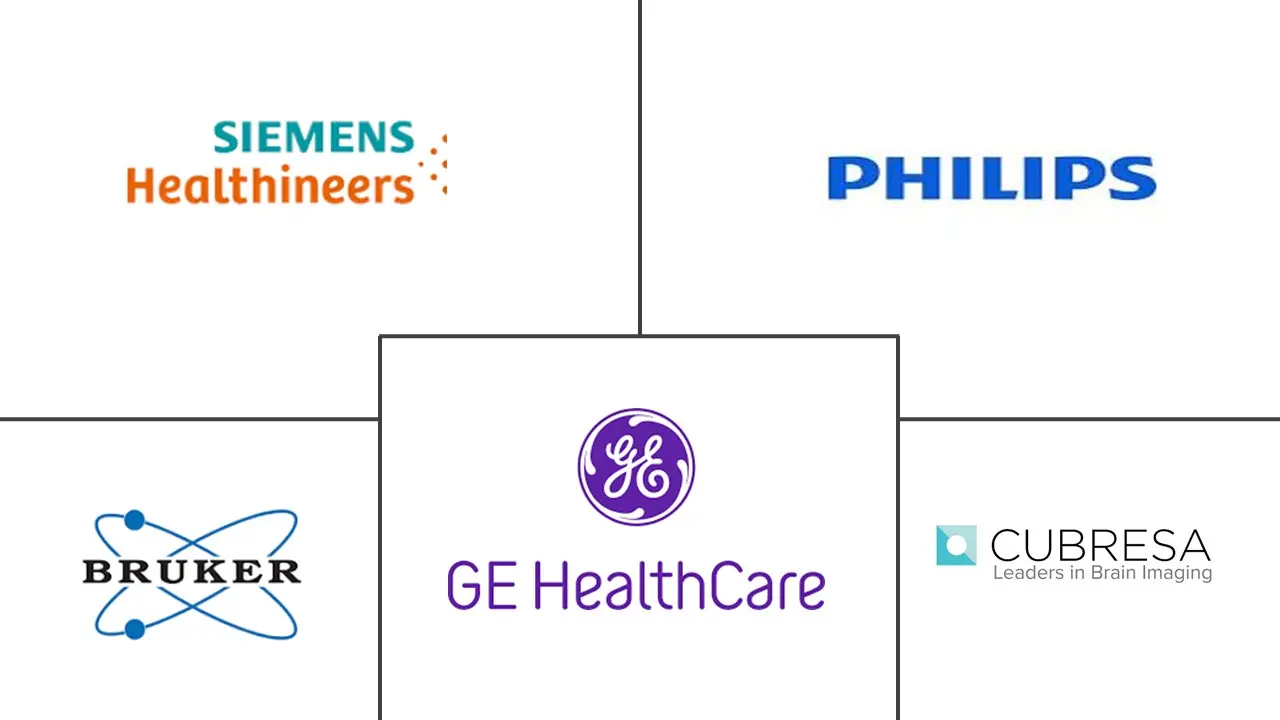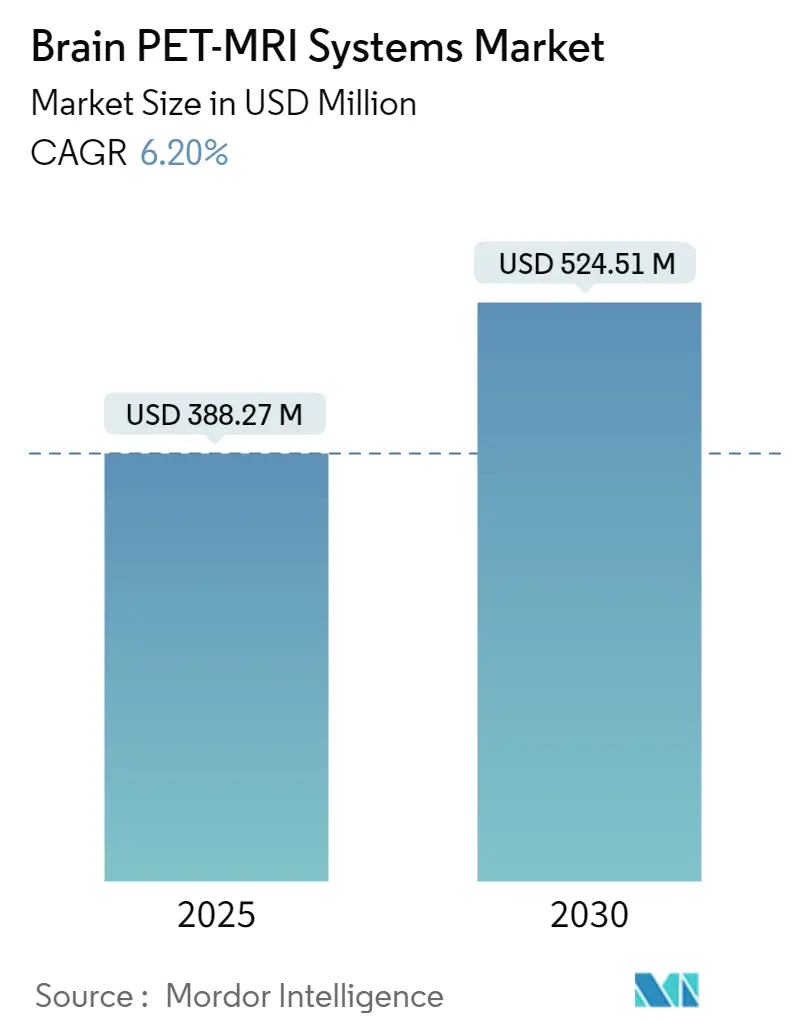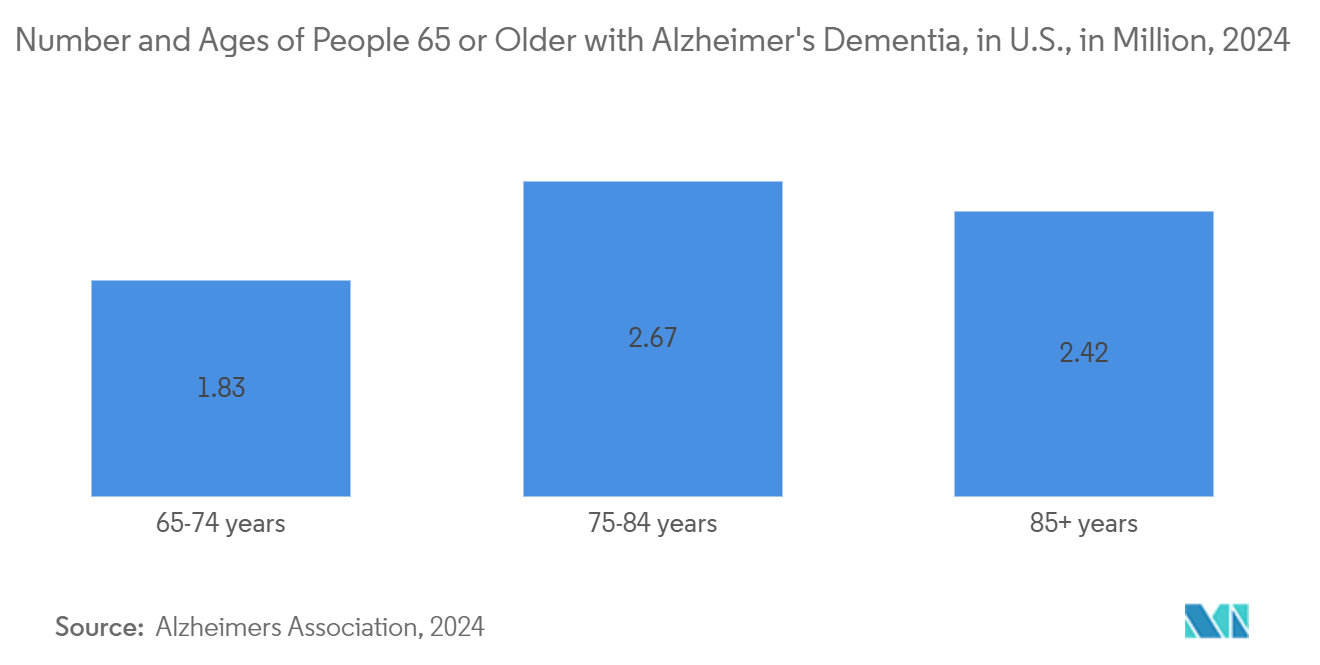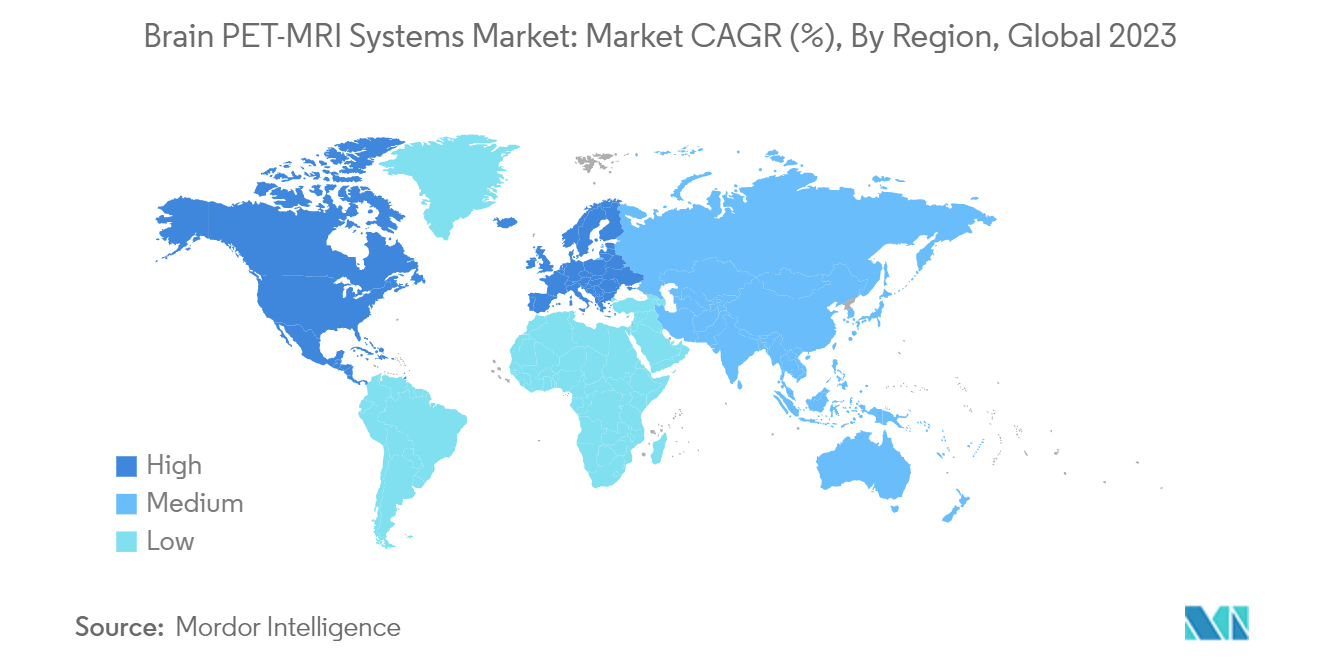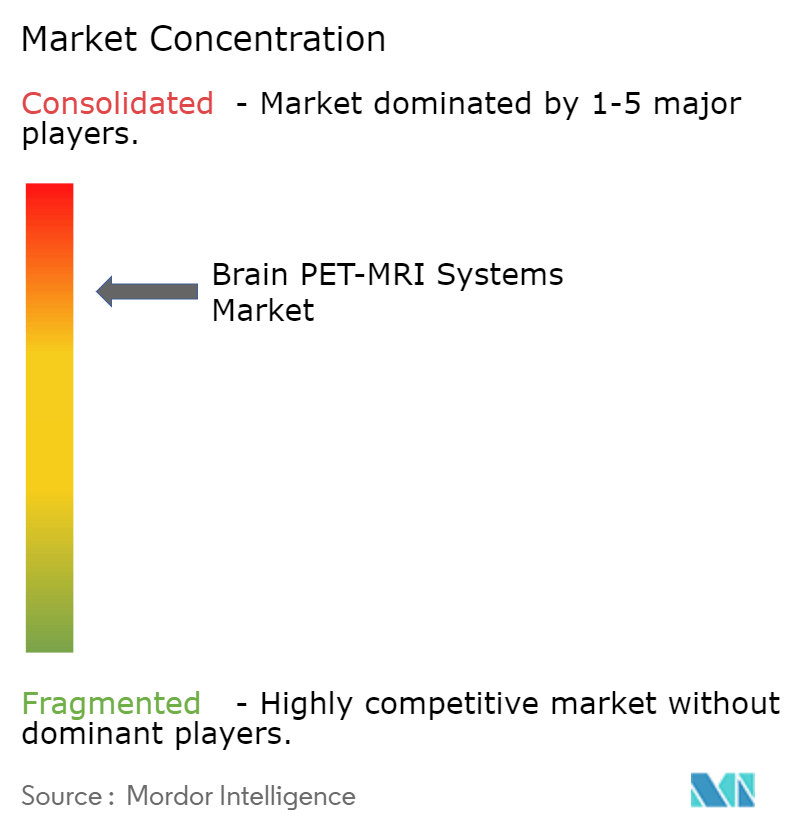Brain PET-MRI Systems Market Analysis
The Brain PET-MRI Systems Market size is estimated at USD 388.27 million in 2025, and is expected to reach USD 524.51 million by 2030, at a CAGR of 6.2% during the forecast period (2025-2030).
The rising prevalence of neurological disorders is a key factor propelling the market growth. For instance, a study published by the World Federation of Neurology in October 2023 stated that more than 40% of the world's population suffers from a neurological condition, with this figure projected to nearly double by 2050. Similarly, a research article in Lancet Neurology in March 2024 highlighted stroke, neonatal encephalopathy (brain injury), migraine, Alzheimer’s disease, and diabetic neuropathy as leading contributors to health loss. Thus, the growing burden of neurological disorders drives demand for advanced imaging modalities like PET-MRI.
Moreover, the rising elderly population suffering from neurological conditions is another factor driving the market growth. This age group is more susceptible to neurological conditions such as dementia, Alzheimer’s disease and Parkinson’s Disorder. According to the WHO, the number of people aged 60 years and older is projected to reach 2.1 billion by 2050, doubling from 1 billion in 2020. Also, by 2030, 1 in every 6 people is expected to be aged 60 and above, globally. The data published by the Alzheimer's Association stated the number of people suffering from Alzheimer's is projected to surge to around 13 million by 2050. This evolving demographic landscape drives demand for advanced diagnostic imaging technologies like PET-MRI.
Furthermire, innovations like the adoption of stronger magnetic field strengths such as 7T scanners, and enhanced PET detector sensitivity are further fueling the market growth. Besides, novel imaging agents also considerably enhance the ability to detect subtle neurological diseases, including brain tumors and early-stage neurodegenerative diseases. Besides, custom-designed radiotracers, targeting specific neurotransmitter systems, receptors, or metabolic pathways, are transforming imaging studies. In addition, new MRI technologies, such as synthetic MRI and fingerprinting techniques, are becoming promising in research, especially when combined with artificial intelligence reconstruction methods. Thus, these advances are accelerating the expansion of the PET-MRI market.
However, the high investment cost of brain PET-MRI systems, lack of skilled professionals, and low accessibility in low-income countries restrain market growth.
Brain PET-MRI Systems Market Trends
Clinical PET-MRI systems Segment is Expected to Witness Substantial Growth Over the Forecast Period
PET-MRI systems play a crucial role in the brain, serving as vital instruments for diagnostics, treatment monitoring, and optimizing therapeutic approaches in clinical settings. These cutting-edge technologies leverage real-time imaging data to track disease progression, assess treatment efficacy, and adjust therapeutic strategies accordingly. These systems diagnose a range of neurological conditions, including Alzheimer's disease, brain tumors, Parkinson's disease, epilepsy, and other neurodegenerative disorders. They enable a deep understanding of the intrinsic and extrinsic pathological changes that involve the structure and function of the brain.
These new systems include PET with enhancements like improved axial coverage, increasing its sensitivity. They also have an upgraded MRI system featuring a new magnet and a wider bore diameter. In addition, advanced imaging software that improves clinical throughput by employing complex imaging sequences has been incorporated into these systems. As a result, acquisition times are reduced to 25–30 minutes, and MRI sensitivity is heightened. As per the research study published in Springer journal (in June 2023), the results from the survey (endorsed by the European Association of Nuclear Medicine (EANM) and the EANM Forschungs GmbH (EARL)) indicated that clinical purposes accounted for an average of 55.5% of PET/MRI usage, while research purposes made up 44.3%.
Furthermore, the rising adoption of PET-MRI technology in hospitals and diagnostic centers for standard clinical evaluations has fueled the segment's expansion. The Alzheimer's Association highlights that timely detection and intervention in neurological disorders curtail treatment expenses and enhance patients' quality of life, thereby boosting the demand for advanced imaging solutions such as PET-MRI. Furthermore, the recent regulatory approval of new PET radiotracers designed to target specific brain disorders has expanded the clinical use of PET-MRI systems. Hence, due to the abovementioned factors, the clinical PET-MRI systems segment is expected to witness significant growth in the upcoming years.
North America is Expected to Dominate the Brain PET-MRI Systems Market during the Forecast Period
North America is projected to dominate the market owing to factors such as the growing adoption of advanced diagnostic systems in research centers, advanced healthcare infrastructure and the presence of established players in the region. The U.S. is home to leading medical research institutions, including the National Institutes of Health (NIH) and the Mayo Clinic, which spearhead advancements in neurological research and neuroimaging. Lately, in December 2023, Quibim launched QP-Brain and received FDA approval. It is an AI-driven tool that seamlessly integrates with PACS, automatically quantifying and presenting results derived from MRI scans.
Moreover, UCSF researchers have explored many uses of this innovative technology to date. The UCSF Radiopharmaceutical Facility can produce over 30 radiotracers for PET/MRI research. Similarly, the Center for Radiochemistry Research is actively developing new radiopharmaceuticals to enhance the capabilities of PET/MRI. Besides, it provides physicians and researchers from the Advanced Imaging Research Center, Knight Cancer Institute, Knight Cardiovascular Institute, and various other OHSU research groups with a platform to collaborate on innovative clinical and research initiatives.
Furthermore, the market in this region is driven by a rising geriatric population suffering from neurological disorders. For instance, in 2023, a report from the Alzheimer's Association stated that around 6.7 million American population aged 65 and above were diagnosed with Alzheimer's disease, emphasizing the growing demand for sophisticated diagnostic imaging tools such as PET-MRI. In addition, major players such as Koninklijke Philips N.V., Siemens Healthineers, Bruker, and GE Healthcare contribute to regional dominance due to their diverse PET-MRI systems portfolios and extensive distribution networks.
Nonetheless, several prominent players in the market are focused on launching novel products, which in turn is projected to create numerous growth opportunities for the market, thereby influencing market growth in the region. For instance, in June 2023, GE Healthcare launched its Signa PET/MRI AIR at the Society of Nuclear Medicine and Molecular Imaging's 2023 annual meeting in Canada. This novel system will improve diagnostic accuracy, streamline treatment assessments, and elevate patient comfort. Such strategic initiatives by key players contribute to market growth. Therefore, owing to the factors mentioned above, the growth of the studied market is anticipated in the North American region.
Brain PET-MRI Systems Industry Overview
The brain PET-MRI systems market is consolidated in nature due to the presence of few major companies operating globally as well as regionally. The competitive landscape includes an analysis of a few international as well as local companies which hold significant market share and are well known which include Bruker,Cubresa Inc., GE Healthcare, Koninklijke Philips N.V., and Siemens Healthineers AG among others.
Brain PET-MRI Systems Market Leaders
-
Siemens Healthineers AG
-
Koninklijke Philips N.V.
-
GE HealthCare
-
Bruker
-
Mediso Ltd.
-
MR Solutions
-
Cubresa Inc.
-
Aspect Imaging Ltd.
- *Disclaimer: Major Players sorted in no particular order
Brain PET-MRI Systems Market News
- February 2024: Philips launched its Smart Quant Neuro 3D. This AI-driven quantitative brain imaging tool, integrated with MR technology, empowers healthcare providers with enhanced diagnostic confidence. This technology automatically measures different brain tissues, helping in brain disease management, tracking disease progression, and evaluating therapy effectiveness.
- May 2023: Cubresa installed its first BrainPET Insert System at St. Joseph’s Health Care London in collaboration with Lawson Health Research Institute. The Cubresa BrainPET, a high-performance and removable PET scanner, is tailored for PET/MRI brain imaging.
Brain PET-MRI Systems Industry Segmentation
The PET/MRI scan combines positron emission tomography (PET) and magnetic resonance imaging (MRI) into one test. This hybrid technology produces highly detailed images of the body. Doctors use these images to diagnose conditions and plan treatments. These scans help in the diagnosis of Alzheimer's disease, epilepsy, and brain tumors.
The brain PET-MRI systems market is segmented into product, phase, end-user, and geography. By product, the market is segmented into traditional brain PET-MRI systems and Helium-free PET-MRI systems. By phase, the market is segmented into pre-clinical and clinical. By end-user, the market is segmented into hospitals, diagnostic imaging centers and other end users. By geography the market is segmented into North America, Europe, Asia-Pacific, and Rest of the World. The report also offers the market size and forecasts for 13 countries across the region. For each segment, the market sizing and forecasts have been done on the basis of value (USD).
| By Product | Traditional PET-MRI Systems | ||
| Helium-free PET-MRI Systems | |||
| By Phase | Pre-clinical | ||
| Clinical | |||
| By End User | Hospitals | ||
| Diagnostic Imaging Centers | |||
| Others | |||
| Geography | North America | United States | |
| Canada | |||
| Mexico | |||
| Europe | Germany | ||
| United Kingdom | |||
| France | |||
| Italy | |||
| Spain | |||
| Rest of Europe | |||
| Asia-Pacific | China | ||
| Japan | |||
| India | |||
| Australia | |||
| South Korea | |||
| Rest of Asia-Pacific | |||
| Rest of World | |||
Brain PET-MRI Systems Market Research FAQs
How big is the Brain PET-MRI Systems Market?
The Brain PET-MRI Systems Market size is expected to reach USD 388.27 million in 2025 and grow at a CAGR of 6.20% to reach USD 524.51 million by 2030.
What is the current Brain PET-MRI Systems Market size?
In 2025, the Brain PET-MRI Systems Market size is expected to reach USD 388.27 million.
Who are the key players in Brain PET-MRI Systems Market?
Siemens Healthineers AG, Koninklijke Philips N.V., GE HealthCare, Bruker, Mediso Ltd., MR Solutions, Cubresa Inc. and Aspect Imaging Ltd. are the major companies operating in the Brain PET-MRI Systems Market.
Which is the fastest growing region in Brain PET-MRI Systems Market?
Asia Pacific is estimated to grow at the highest CAGR over the forecast period (2025-2030).
Which region has the biggest share in Brain PET-MRI Systems Market?
In 2025, the North America accounts for the largest market share in Brain PET-MRI Systems Market.
What years does this Brain PET-MRI Systems Market cover, and what was the market size in 2024?
In 2024, the Brain PET-MRI Systems Market size was estimated at USD 364.20 million. The report covers the Brain PET-MRI Systems Market historical market size for years: 2019, 2020, 2021, 2022, 2023 and 2024. The report also forecasts the Brain PET-MRI Systems Market size for years: 2025, 2026, 2027, 2028, 2029 and 2030.
Brain PET-MRI Systems Industry Report
Statistics for the 2025 Brain PET-MRI Systems market share, size and revenue growth rate, created by Mordor Intelligence™ Industry Reports. Brain PET-MRI Systems analysis includes a market forecast outlook for 2025 to 2030 and historical overview. Get a sample of this industry analysis as a free report PDF download.

